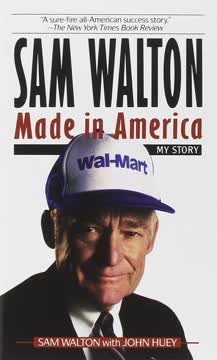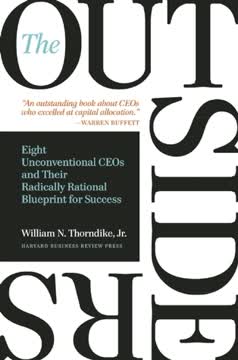Key Takeaways
1. From Immigrant to Fruit Empire: The Rise of Sam Zemurray
"You're there, we're here; Go see for yourself; Don't trust the report."
Humble beginnings. Samuel Zemurray arrived in America in 1891 at age 14, penniless and speaking no English. He started working in his uncle's store in Selma, Alabama, where he first encountered bananas. Recognizing their potential, Zemurray began buying and selling overripe bananas, which other traders discarded.
Entrepreneurial spirit. Zemurray's success was built on his willingness to take risks and his hands-on approach to business. He traveled extensively in Central America, learning the banana trade from the ground up. This firsthand knowledge gave him a significant advantage over his competitors.
Building an empire. By 1905, Zemurray had founded the Cuyamel Fruit Company, which would eventually rival the powerful United Fruit Company. His company grew rapidly, acquiring land in Honduras and developing innovative farming and transportation methods. Zemurray's rise from a poor immigrant to a powerful businessman epitomizes the American Dream and demonstrates the opportunities available in the early 20th century for those willing to work hard and take risks.
2. Ripe Opportunities: Zemurray's Innovative Approach to the Banana Trade
"A mule costs more than a deputy."
Seeing value in waste. Zemurray's initial success came from selling "ripes" - bananas considered too ripe for sale by other traders. This innovative approach allowed him to enter the market with minimal capital and build a profitable business from what others saw as waste.
Vertical integration. As his business grew, Zemurray implemented a strategy of vertical integration, controlling every aspect of the banana trade:
- Acquiring land in Honduras for plantations
- Building railroads to transport bananas
- Purchasing ships to carry fruit to the United States
- Developing distribution networks in American cities
Political maneuvering. Zemurray understood that success in the banana trade required more than just business acumen. He became adept at navigating the complex political landscape of Central America, using his influence and resources to shape policies favorable to his business interests. This often involved questionable practices, such as bribing officials or supporting coups, which would later become a source of controversy.
3. United Fruit Company: The Birth of a Multinational Giant
"El Pulpo" (The Octopus)
Merger and growth. In 1929, Zemurray sold Cuyamel Fruit Company to United Fruit for $31.5 million in stock, becoming the largest shareholder. However, dissatisfied with the company's management during the Great Depression, he orchestrated a takeover in 1933, famously telling the board, "You gentlemen have been fucking up this business long enough. I'm going to straighten it out."
Expansion and dominance. Under Zemurray's leadership, United Fruit became a true multinational corporation:
- Controlled vast tracts of land across Central America
- Owned the largest private navy in the world (the "Great White Fleet")
- Employed over 100,000 workers
- Dominated the global banana trade
Corporate power. United Fruit's influence extended far beyond the banana trade. The company's reach into politics, infrastructure, and daily life in many Central American countries led to the coining of the term "banana republic," reflecting the degree to which these nations' economies and governments were controlled by the fruit company.
4. Power and Politics: Zemurray's Influence in Central America
"For Chris-sakes, your problem is not bananas, you've got to handle your political problem."
Shaping governments. Zemurray was not content to merely operate within existing political structures. He actively worked to shape governments in Central America to benefit his business interests. This included:
- Supporting coups in Honduras (1911) and Guatemala (1954)
- Cultivating relationships with political leaders
- Lobbying the U.S. government to intervene in Central American affairs
Propaganda and influence. Zemurray employed public relations pioneer Edward Bernays to manage United Fruit's image and influence public opinion. Bernays orchestrated campaigns to portray Central American governments as communist threats, justifying U.S. intervention that benefited United Fruit.
Long-term consequences. While Zemurray's political maneuvering benefited United Fruit in the short term, it had lasting negative impacts on Central American countries. The instability and economic inequality fostered by these actions contributed to decades of political unrest and underdevelopment in the region.
5. The Banana Republic: United Fruit's Impact on Honduras and Guatemala
"There's a battle waging, and you're on one side or the other, even if you don't know it."
Economic dominance. United Fruit's control over Central American economies was staggering:
- Owned 70% of all private land in Guatemala
- Controlled 75% of all trade in Guatemala
- Owned most roads, power stations, and communication infrastructure
Social and political impact. The company's dominance extended beyond economics, shaping the social and political landscape of these countries:
- Created a two-tiered society: wealthy company executives and impoverished local workers
- Influenced government policies to maintain favorable business conditions
- Suppressed labor movements and political opposition
Resistance and backlash. The 1950s saw growing resistance to United Fruit's dominance, culminating in the election of reformist governments in Guatemala and Honduras. When these governments attempted to implement land reforms and labor protections, United Fruit, with Zemurray's backing, worked to undermine and overthrow them, leading to decades of political instability and conflict.
6. Innovation and Adaptation: Zemurray's Leadership of United Fruit
"You put the medicine on the leaves and that cures the disease?"
Agricultural innovations. Under Zemurray's leadership, United Fruit implemented numerous innovations to improve banana production:
- Selective pruning
- Advanced drainage systems
- Overhead irrigation
- Staking of banana plants
Disease management. When Panama disease threatened to wipe out banana plantations, Zemurray directed the company to:
- Develop new disease-resistant banana varieties
- Implement crop rotation and fallow field strategies
- Invest in research and development
Diversification. During World War II, when banana shipments were disrupted, Zemurray pivoted the company towards other tropical crops:
- Quinine for anti-malaria medication
- Hemp for rope production
- Rubber for the war effort
These adaptations showcased Zemurray's ability to navigate challenges and find new opportunities, keeping United Fruit profitable even in difficult times.
7. The Legacy of Sam Zemurray: Triumph, Controversy, and Reflection
"I feel guilty about some of the things we did. All we cared about was dividends. Well, we can't do business that way today."
Business success. Zemurray's career was a testament to the power of innovation, hard work, and adaptability in business. He built one of the most powerful corporations of the 20th century, transforming the global fruit trade and amassing immense personal wealth.
Controversial legacy. However, Zemurray's methods and the impact of United Fruit on Central America remain deeply controversial:
- Exploitation of workers and natural resources
- Interference in sovereign nations' politics
- Contributing to long-term economic and political instability in the region
Philanthropy and reflection. In his later years, Zemurray engaged in significant philanthropic efforts:
- Major donations to Tulane University
- Support for medical research and hospitals
- Funding for the creation of the state of Israel
He also expressed regret for some of his past actions, recognizing the negative impacts of his business practices. Zemurray's life story encapsulates both the opportunities and the ethical challenges of American capitalism in the early 20th century, serving as a complex case study of entrepreneurship, power, and responsibility.
Last updated:
FAQ
What's The Fish That Ate the Whale about?
- Biography of Sam Zemurray: The book chronicles the life of Samuel Zemurray, a Russian immigrant who became a powerful figure in the banana trade and the president of the United Fruit Company.
- American Century Context: Zemurray's story is set against the backdrop of the American Century, illustrating the complexities of American expansionism, corporate power, and the impact on Central America.
- Themes of Power and Corruption: The narrative explores themes of ambition, corruption, and the moral ambiguities of capitalism, particularly in the context of foreign interventions and corporate influence in politics.
Why should I read The Fish That Ate the Whale?
- Insight into Corporate History: The book provides a detailed look at the banana industry and the rise of multinational corporations, offering insights into how business practices shaped modern economies.
- Engaging Storytelling: Rich Cohen's narrative style combines historical facts with vivid storytelling, making it an engaging read for those interested in history, business, or personal stories of ambition.
- Lessons on American Exceptionalism: The book serves as a case study on American exceptionalism, illustrating both the opportunities and the darker sides of pursuing the American Dream.
What are the key takeaways of The Fish That Ate the Whale?
- Power is Perception: The book emphasizes that "Power is based on perception. If you think you got it, you got it, even if you don’t got it," highlighting the importance of self-image in business and politics.
- The American Dream's Complexity: Zemurray's life illustrates the duality of the American Dream—success achieved through hard work and ambition, but often at the expense of ethical considerations and the well-being of others.
- Impact of Corporate Influence: The narrative reveals how corporate interests can shape foreign policy and local governance, as seen in Zemurray's dealings with the Honduran government.
What are the best quotes from The Fish That Ate the Whale and what do they mean?
- "In my beginning is my end.": This quote reflects the cyclical nature of Zemurray's life, suggesting that his humble beginnings were intrinsically linked to his eventual downfall and the complexities of his legacy.
- "There’s always a guy.": This phrase captures the essence of the unpredictable nature of business and politics, indicating that there is always someone ready to take advantage of a situation, for better or worse.
- “You gentlemen have been fucking up this business long enough. I’m going to straighten it out.”: This quote captures Zemurray's determination and assertiveness in reclaiming control over United Fruit, reflecting his belief in his ability to effect change.
How did Sam Zemurray rise to power in the banana industry?
- Started with Ripes: Zemurray began his career by selling "ripes," or overripe bananas that others discarded, demonstrating his ability to see value where others did not.
- Acquisition of Land: He strategically acquired land in Honduras, leveraging his knowledge of the banana trade and local politics to build a successful plantation business.
- Coup and Influence: Zemurray orchestrated a coup to install a friendly government in Honduras, which allowed him to secure favorable concessions and expand his business operations.
What role did United Fruit Company play in Zemurray's story?
- Corporate Rivalry: United Fruit was both a competitor and a partner for Zemurray, representing the larger corporate interests in the banana trade that he sought to challenge and eventually merge with.
- Symbol of American Imperialism: The company is depicted as a symbol of American imperialism, using its power to influence foreign governments and exploit local resources, which Zemurray both benefited from and fought against.
- Merger Outcome: Ultimately, Zemurray's merger with United Fruit allowed him to secure his legacy and financial future, but it also meant he had to navigate the complexities of corporate governance and ethics.
How did Zemurray's actions affect Central America?
- Political Interventions: Zemurray's influence led to significant political interventions in countries like Honduras and Guatemala, where he supported coups to protect United Fruit's interests.
- Economic Exploitation: The practices of United Fruit under Zemurray's leadership often exploited local labor and resources, leading to economic disparities.
- Cultural Impact: The actions of United Fruit contributed to the perception of the U.S. as an imperial power in Latin America, shaping cultural narratives around American intervention.
What were the consequences of Zemurray's actions in Honduras?
- Political Instability: Zemurray's involvement in the coup against President Dávila contributed to ongoing political instability in Honduras, as foreign interests often clashed with local governance.
- Corporate Power Dynamics: His actions exemplified the power dynamics between multinational corporations and sovereign nations, raising questions about sovereignty and the ethics of intervention.
- Legacy of Exploitation: While Zemurray achieved personal success, his story also reflects the broader legacy of exploitation and the impact of corporate greed on local populations.
How did Zemurray's background influence his business practices?
- Immigrant Experience: Zemurray's experience as an immigrant shaped his understanding of opportunity and risk, driving him to work tirelessly to achieve success in a foreign land.
- Connection to the Land: Growing up on a farm instilled in him a deep appreciation for agriculture, which informed his innovative practices in banana cultivation and plantation management.
- Cultural Adaptation: His ability to adapt to local cultures and languages allowed him to build strong relationships with workers and local leaders, which was crucial for his business success.
How did The Fish That Ate the Whale address the theme of colonialism?
- Corporate Colonialism: The book illustrates how United Fruit operated as a colonial power in Central America, exerting control over land and labor.
- Cultural Imperialism: Cohen discusses the cultural implications of United Fruit's dominance, including the imposition of American values and practices on local populations.
- Resistance and Revolution: The narrative highlights the resistance movements that emerged in response to corporate colonialism, showcasing the struggles of local populations against foreign domination.
What lessons can be learned from The Fish That Ate the Whale?
- Importance of Ethical Business Practices: The book serves as a reminder of the need for ethical considerations in business decisions.
- Understanding Historical Context: Readers are encouraged to consider the historical context of corporate actions and their impacts on communities.
- The Power of Individual Agency: The narrative emphasizes the role of individuals in shaping history, encouraging readers to recognize their own potential for impact.
How does The Fish That Ate the Whale relate to contemporary issues?
- Corporate Influence in Politics: The book raises questions about the ongoing influence of corporations in political decision-making, particularly in foreign policy.
- Globalization and Exploitation: Zemurray's story reflects the challenges of globalization, including the exploitation of labor and resources in developing countries.
- Legacy of Interventionism: The narrative serves as a historical lens through which to view contemporary U.S. foreign policy in Latin America and beyond.
Review Summary
The Fish That Ate the Whale tells the fascinating story of Samuel Zemurray, a Russian immigrant who became America's "Banana King." Readers praise Cohen's engaging writing style and the book's exploration of United Fruit Company's influence on Central American politics. Some criticize the author's tangents and occasional lack of objectivity. Many found the historical context and Zemurray's rise to power captivating, though opinions varied on the book's overall effectiveness. While some felt it was too long or rambling, others appreciated the depth of research and compelling narrative.
Similar Books










Download PDF
Download EPUB
.epub digital book format is ideal for reading ebooks on phones, tablets, and e-readers.




